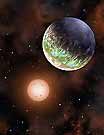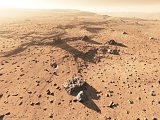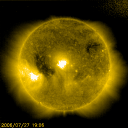The Universe as a Human Body:
Schramm's figures for relative abundances indicate that helium is about 25% by mass and hydrogen about 73% with all other elements constituting less than 2%
[NB, I assume this is non-dark-matter, 'baryonic' I believe it's called, because we don't really know just what the 'dark matter' is, if in fact it's there.]
If a person weighs, say, 80kg & <koff&> virtually none is Helium, there's a fair chunk of Hydrogen, as part of carbohydrates (sugars, starches, alcohols, etc), hydrocarbons (fatty stuff), and the rest — most of a body — is made up of the 2% of the universe that isn't either of those. But if I were 80kg, and also The Universe (not counting Dark Matter, which may be my deep secrets and despair, or unconscious mind, or perhaps my spirit or soul), 2% of me would be 1.6 kg (~3.5 lb). Maybe a forearm, or both forearms, or a leg below the knee? I wonder how long a chunk of intestines would weigh that (empty of course). Which would be all the elements and compounds we know apart from hydrogen & helium.
Should I mention that a fair chunk of every human body is non-human cells? Bacteria & protozoa that we carry about on & inside ourselves. Not a particularly large amount by weight, but a lot if you count each human cell as equivalent to a single bacterium or single-celled protozoan.
Also see
imagine.gsfc.nasa.gov/docs/ ask_astro/answers/971113i.html (one of the answers in Goddard Space Centre's "Ask an Astrophysicist" section - imagine.gsfc.nasa.gov/docs/ask_astro/ask_an_astronomer.html
Cosmology - Birth and Death of the Universe
physics.gmu.edu/~jevans/ astr103/CourseNotes/Ppt/ Lec09_pt2_cosmologyModern/ tsld001.htm
Significant Eras back to Big Bang
Present era = 10 -20 x 109 years after big bang
Matter era = <106 years after big bang
Radiation era = 1 s to 106 years after big bang
Lepton era = 10-4 to 1 s after big bang
Hadron era = 10-4 to 10-23 s after big bang
Quark era = 10-23 s to 10-43 s after big bang
Planck era = earlier than 10-43 s
An independent media collective at the University of Connecticut
Perhaps these people can find themselves in the line of descent of New Journalism
uconnfreepress.org
UConn Free Press is an alternative student-run newspaper. We are an anti-profit weekly publication serving the university and local community. We are dedicated to carrying out the tradition of participatory democracy through staff consensus in all matters concerning the paper. We welcome article and art submissions via www.freeuconn.com or uconnfreepress@gmail.com. Consider, criticize, and debate.
Music, Theatre & Dance: A Performing Arts Digital Library
The Library of Congress » Performing Arts Reading Room
This Web site, formerly known as "I Hear America Singing," invites visitors to experience the diversity of American performing arts through the Library of Congress's unsurpassed collections of scores, sheet music, audio recordings, films, photographs, maps, and other materials.
www.loc.gov/rr/perform/ ihas/lcp-home.html
Search Individual Collections
Civil War Sheet Music - lcweb2.loc.gov/cocoon/ ihas/html/civilwar/ civilwar-home.html
A collection of over 2500 titles of music about the Civil War.
Volcano of Delight: Historic Sheet Music, 1800-1922 - lcweb2.loc.gov/cocoon/ihas/ html/volcano/ volcano-home.html
A collection of over 9,000 titles published in the U.S. and Europe.
View Other Special Presentations ...
[includes currently]
A Jazz and Blues Filmography by David Meeker,
lcweb2.loc.gov/cocoon/ ihas/html/jots/ jazzscreen-home.html
a searchable database documenting the work of some 1,000 major jazz and blues figures in over 14,000 cinema, television and video productions.
Ask a Librarian - www.loc.gov/rr/askalib/ask-perform.html
Labour Music links (mp3, rm, midi, & links to lyrics): www.marxists.org/subject/art/music/index.htm
Sheet Music to "International" (1870) : www.marxists.org/subject/art/music/internationale.pdf [PDF]
Esperanto version: www.uv.es/pla/red.net/intesper.html
Listen to the most festive rendition of "The Internationale" ever ( mirukashihime.cool.ne.jp/sound/int_sfms.mp3 [MP3] ), played by a Japanese band Soul Flower Mononoke Summit ( www.breast.co.jp/soulflower ). Sort of a Japanese Klezmer version. Here are the lyrics written in in Japanese mirukashihime.cool.ne.jp/ sound/interjap2.GIF
( via Literary Montages)
This is a good source for the lyrics in parallel versions in several languages, including Asian ones.
The Internationale
(from en.wikipedia.org/wiki/The_Internationale )
Note there are also links here to Writers & other forms of art.











